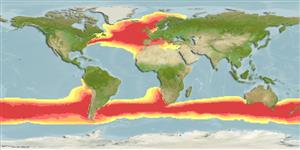sub class Elasmobranchii (ฉลามและกระเบน) (sharks and rays) >
Lamniformes (Mackerel sharks) >
Lamnidae (Mackerel sharks or white shark)
Etymology: Lamna: Greek, lamna, -es = a shark (Ref. 45335); nasus: Latin: nasus, nose (Ref.89261).
ภาวะแวดล้อม / สภาพภูมิอากาศ / พิสัย
นิเวศวิทยา
; เกี่ยวกับทะเล,น้ำเค็ม; สัตว์น้ำที่อาศัยและอพยพภายในทะเลเท่านั้น (Ref. 51243); ระดับความลึก 0 - 715 m (Ref. 26346). Temperate; 1°C - 18°C (Ref. 6871), preferred 17°C (Ref. 107945); 76°N - 59°S, 180°W - 180°E (Ref. 247)
Circumglobal, amphitemperature with centers of distribution in the North Atlantic and temperate water of the southern hemisphere; not in equatorial seas. Appendix III (Mediterranean) of the Bern Convention (2002). Appendix II of the Bonn Convention (2009).
Length at first maturity / ขนาด / น้ำหนัก / Age
Maturity: Lm 175.0, range 170 - 180 cm
Max length : 350 cm TL เพศผู้/กระเทย; (Ref. 4645); common length : 244 cm TL เพศผู้/กระเทย; (Ref. 5951); น้ำหนักสูงสุดที่มีการรายงาน: 230.0 kg (Ref. 40637); อายุสูงสุดที่ได้รายงาน: 30 ปี (Ref. 247)
เงี่ยงครีบหลัง (รวม): 0; ก้านครีบอ่อนที่หาง (รวม): 0; เงี่ยงครีบก้น 0; ก้านครีบอ่อนที่ก้น: 0. A stout, spindle-shaped shark with large black eyes, a sharp, conical snout, long gill slits, and small, smooth-edged, narrow teeth with side cusps (Ref. 5578, 88171). Strong keels on the caudal peduncle, short secondary keels on the caudal base, and a crescentic caudal fin; the insertion of the small second dorsal fin is above the insertion of the anal fin (Ref. 88171). Dark grey dorsally, white ventrally, without blotches (Ref. 6581, 43278); rear tip of 1st dorsal abruptly white (Ref. 5578).
Most abundant on continental offshore fishing banks but also found far from land in ocean basins and occasionally close inshore (Ref. 247). Pelagic, epipelagic or littoral shark. Highly migratory, moves generally along the continental shelves. Specimens tagged off southern England were recaptured in northern Norway (having travelled 2,370 km), Denmark and Spain (Ref. 88752, 88753). The northwest Atlantic stock migrates from Newfoundland, Canada in the winter to Massachusetts in the summer (Ref. 43278, 88754). Trans-Atlantic migrations have also been recorded. One of the most cold-tolerant sharks; in the northwest Atlantic mostly found from 5-10°C (Ref. 88755). Known to temporarily tolerate salinities as low as 10 to follow its prey (Ref. 88740). Found singly and in schools and feeding aggregations (Ref. 247). Feeds on small and medium-sized pelagic schooling species, other sharks, squid (Ref. 5578) and demersal fishes (cod, white hake, red hake, haddock and cusk (Ref. 5951, 43278)). Ovoviviparous species (Ref. 43278, 50449). Females grow larger than males (Ref. 88756). Catch records and studies in the northeast Atlantic show segregation by sex and size (Ref. 56108, 88756, 88757). Parasites include Phyllobothrium dagnallium (found in stomach, intestine and spiral valve) and Dinobothrium sp. (Ref. 5951). Regarded as potentially dangerous to people because of its size and activity but has never or very seldom been indicted in an attack on people or boats (Ref. 247). Excellent sportfish (Ref. 84357). The flesh of the porbeagle is of good quality and texture and is said to taste like swordfish (Ref. 84357). Utilized fresh, dried or salted and frozen for human consumption; for oil and fishmeal; fins for shark-fin soup (Ref. 247). May be pan-fried and broiled (Ref. 9988).
Distinct pairing with embrace (Ref. 205). Ovoviviparous (aplacental viviparity), with uterine cannibalism (embryos feeding on other ova produced by the mother (oophagy) after the yolk sac is absorbed) (Ref. 43278, 50449). With 1-5 (usually 4) pups in a litter (Ref. 6871, 43278). Reproduction probably yearly (Ref. 45602). In the northeast Atlantic, breeding grounds are off the coast of Europe and the British Isles. Embryos found in mature females throughout the year except from July to September. Mating occurs in late summer, pups are born in the spring of the following year (Ref. 43278). Gestation may last 8-9 months. Size at birth 60-80 cm TL (Ref. 6871, 43278).
Compagno, L.J.V., 1984. FAO Species Catalogue. Vol. 4. Sharks of the world. An annotated and illustrated catalogue of shark species known to date. Part 1 - Hexanchiformes to Lamniformes. FAO Fish. Synop. 125(4/1):1-249. Rome, FAO. (Ref. 247)
IUCN Red List Status (Ref. 115185)
Threat to humans
Traumatogenic (Ref. 4690)
Human uses
การประมง: การค้า; การตกปลาเป็นกีฬา: ใช่
เครื่องมือ
Special reports
Download XML
แหล่งที่มาจากอินเตอร์เน็ต
Estimates of some properties based on models
Phylogenetic diversity index (Ref.
82805): PD
50 = 0.7813 [Uniqueness, from 0.5 = low to 2.0 = high].
Bayesian length-weight: a=0.01047 (0.00607 - 0.01808), b=3.03 (2.87 - 3.19), in cm Total Length, based on LWR estimates for this species & (Sub)family-body (Ref.
93245).
ระดับชั้นอาหาร (Ref.
69278): 4.6 ±0.0 se; Based on diet studies.
ความสามารถในการกลับคืนสู่ปกติ (Ref.
69278): ต่ำมาก, เวลาต่ำสุดที่จะทำให้ประชากรเพิ่มขึ้นเป็น 2 เท่าใช้เวลามากกว่า 14 ปี (K=0.12; tm=5; tmax=30; Fec=1-5).
Vulnerability (Ref.
59153): Very high vulnerability (86 of 100) .
